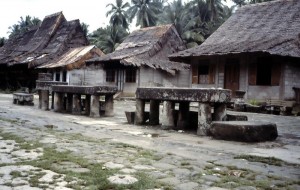The Stones of Austronesia
THE STONES OF AUSTRONESIA
Â
Early Kingdoms of the Indonesian Archipelago and the Malay Peninsula
By Paul Michel Munoz
Editions Didier Millet
Singapore
2006
Â
Edited by Ian Glover and Peter Bellwood
RoutledgeCurzon
New York and Oxford
2004
Â
I have been reading in Bellwood and Glover’s book Southeast Asia: From Pre-History to History and in Paul Munoz’s Early Kingdoms of the Indonesian Archipelago and the Malay Peninsula about the migration of the Austronesians out of southern China and across Southeast Asia and the Pacific. Austronesian speakers dominate islands from Madagascar in the west to Easter Island in the east. They left their homeland about 4 or 5 thousand years ago and their first stop was Taiwan, where there is still a small Austronesian population. From there they went to the Philippines, Borneo, and the Indonesian Archipelago. In 500 BC or so they landed in Central Vietnam, where they would become known as the Cham. The Cham were isolated in a sea of Austroasiatic speakers. To the south and east the Austronesians met the larger indigenous populations of Papua New Guinea and surrounding islands, where they had less of an impact.
Â
The Austronesians brought with them rice agriculture, building with stone, head hunting, superior seafaring abilities, matrilinear descent and a loose political organization. Of these, rice is by far the greatest inheritance, though all of the latter are in evidence in one place or another.
Â
There is far more to rice than the social sciences suggest; there is the taste of rice. We not only eat Arborio rice from Italy (a medium-grained variety with more gluten than the usual long grained rice, hence the oozy, creamy texture of risotto) but Spanish Callaspara and Bomba rices for paella, jasmine rice from Thailand and basmati rice from India. My food coop also carries small packets of Bhutanese rice, red rice and black rice.
Â
When I was in Asia, each of these types of rice was unique to a region. I only ate black rice in Bali, where there was a small wayung in the town of Ubud run by a woman who made black rice pudding with fresh papaya and mango for breakfast. Now this appears on the menus of many different Asian restaurants, and you can buy purple or black sticky rice in any Asian grocery. Like snow in Ireland, black rice is general all over Asia. Sticky rice was common in Thailand as a sweet snack, wrapped in a bamboo or banana leaf, secured with a toothpick, but it was only eaten with a meal in mountainous areas of the north and northeast. (While tripping on mushrooms in Koh Samui I stepped on a sweet rice confection and couldn’t get it off of my foot. Later that day, sitting on the beach, I felt a hot burning liquid pour down my back and was sure I had been shot, but it turned out to be a German Shepard taking a piss on me).
Â
Red rice I had in the Philippines, while staying in an Ifugao village. The Ifugao are a fascinating people. As I said in an earlier post, they live among stone rice terraces built three thousand years ago, in the remote mountains of northern Luzon. They have been raising rice there for millennia. Just as the Andes serve as a genetic bank for wild and domestic potato varieties, so does this part of the Philippines for rice. The Ifugao have traditionally lived on rice and whatever they could hunt, but there is nothing much left to hunt, so that leaves rice, sweet potato and tinned fish.
Â
The Ifugao use of stone is amazing. Their villages are paved with stone, there are sacrificial stone circles of stone, and there are those amazing stone rice terraces. And there is the rice. Our guide promised to feed us, but when it came to meal time there wasn’t a whole lot to eat. A local (and horrible) American missionary explained that they (missionaries) had tried to get people to raise and eat chickens, pigs and goats. These animals were certainly everywhere, as was their fecal matter. The village we stayed in was beautifully laid out in stone, with thatched roof dwellings on stilts, a lovely shallow river for bathing. But the ‘sidewalks’ were treacherous, and the pigs would literally try to eat the shit as it dropped from your ass to the ground. The customs of the people made it almost impossible for them to kill and eat these animals. They would not eat the eggs even because the chickens were so valuable. They were saving the animals up for feasts. Or so the missionary explained. Peter Gatig, our guide, simply opened cans of sardines and put them on to rice. But oh, the rice! Each evening he would have brought to us a large basket of fresh, perfectly cooked rice. He was extremely proud explaining to us what type of rice it was and when it was harvested. Each night it looked and tasted different. The meal I remember most was of red rice, which was pinkish red when cooked and had an incredible nutty, sweet flavor. To accompany this fine rice Peter brought us a special treat, pickled pork. He described how this pork, which was reserved for important occasions, was placed in an earthenware jar and buried in the ground with salt and spices. He opened the jar and gave each of us a small piece the meat. The Ifugao lands are located in the valleys of a large mountain chain and the air is chilly and damp in the evening. It took a while for the odor of the pork to diffuse but when it did it turned out to be the most foul smelling thing imaginable; a sharp, nose piercing stench that soon covered the tongue (without having taken a bite) with a slick of rot. We were too polite not to try a bite, though I am sure Laura and Shelly only brought it to their mouths and pretended to chew, whereas Bob and I actually ate it. Or so I thought. I ate it. It tasted as bad as it smelled and when I was done I smiled at Peter. He said, “Wasn’t that good?†I assured him that it was. Despite the fact that I was the only one to actually eat a chunk, I was the only one who could speak enough to pretend it was delicious. “Would you like another piece then?†He smiled sheepishly as he said this; it was after all very special. “OK,†I said, and to this day I can taste it going down with all of that wonderful rice.
Â
Glover and Bellwood’s Southeast Asia is a collection of scholarly articles written by archaeologists and anthropologists, but is intended for all sorts of readers. It reaches no stylistic heights nor is there a single unifying perspective. It moves from an area perspective to studies of specific regions and its chief virtue is that in a constantly changing field it is new and thorough. The entries on Vietnam are somewhat limited by the ideological framework of Vietnamese social science. The chapter on the Chams, written by William A. Southworth was quite good, as is his dissertation, which I will write about in a later post.
Â
Paul Michel Munoz’s Early Kingdoms is the opposite of the above work. Munoz is an autodidact and his book is a synthetic, narrative history of a region, centered on Srivijaya. This is not an easy history to tell, and he draws heavily on the work of Bellwood and Glover, as well as other authors from that volume. The English could have benefited from a little editing, but I enjoyed reading the book and again, because it is up to date, it is a little less nerve-wracking than older works.
Â
Austronesian is, in the end, a language group. Studying ‘Austronesians’ is a bit like studying ‘Indo Europeans’ say. It is too general. But like the Turks of Central Asia, or the people of the Steppes who periodically swept across Europe to become Celts, Vikings etc. they are a fascinating people who have shaped the modern world, and yet there are few people, outside of specialists, who know anything about them. Of course, I should say that there are few Americans, because those who make up Austronesia or live on its borders know their own history.
Â
Â




